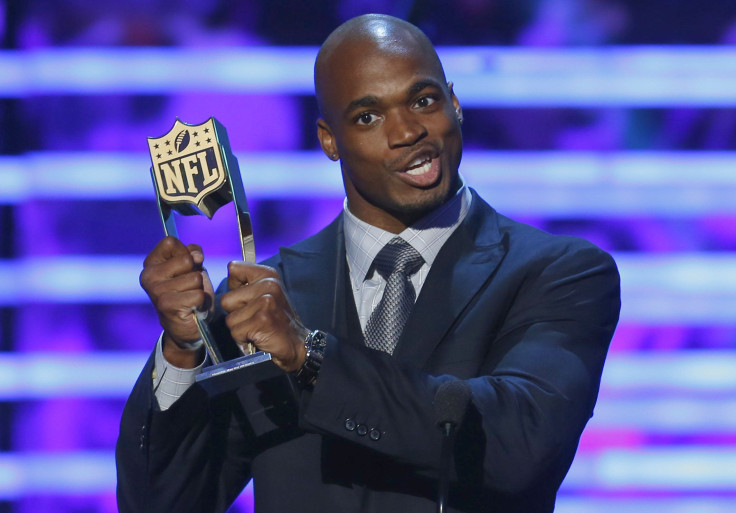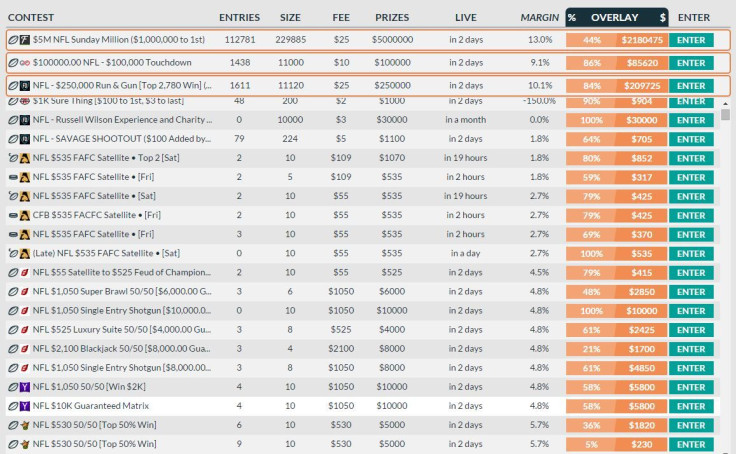FanDuel, DraftKings Scandal: How ESPN, NBC And Sports Leagues Became Addicted To Fantasy Sports

When news trickled out Monday that an employee of DraftKings, a large daily fantasy sports-contest site, won $350,000 playing in a tournament on rival site FanDuel, the sports media world’s next big cash cow appeared to be in peril. After years of uninterrupted growth and good news, companies such as ESPN and others were suddenly having to debate the ethical and regulatory pros and cons of fantasy sports, particularly daily fantasy, a new kind of fantasy sports that many have likened to gambling.
If you’ve been watching the news at all this week, you could be forgiven for thinking that every man, woman and child in America played daily fantasy sports. That said, you’d be wrong. It is hard to find hard numbers on how many daily fantasy players there are in the U.S., but research has indicated it’s still a relatively niche activity. A study conducted by Ipsos in 2013 suggested there were fewer than 10 million daily fantasy players in the country then, and a separate survey of 1,000 fantasy players sponsored by the Fantasy Sports Trade Association in June 2015 suggested that the number could be as high as 16 million, a total that would put it behind the number of American adults who go bowling or play musical instruments.
So why the avalanche of advertisements, the tidal wave of coverage, the eruption of discussion around a game that so few people are playing? It’s because both the major sports leagues and the media companies that cover them see in daily fantasy the chance to reap an enormous amount of money, partly through their coverage and partly through their equity investments in DraftKings and FanDuel.
“People look at the fantasy industry and think it’s making money hand over fist, but it’s not,” said Tim Jensen, the chief operating officer of RealTime Fantasy Sports, which has offered or powered daily fantasy games since 2013. “It’s the media companies who are [profiting].”
Meanwhile, the actual returns for operators such as DraftKings and FanDuel, daily fantasy’s overwhelming market leaders, are fairly modest. Neither company is profitable because of its enormous marketing expenses, and while a few of the smaller players have managed to get into the black, daily fantasy makes more money for the companies that talk about it than the companies that host it. And as long as people continue to talk up this game that a relatively small number of people are playing, it may take daily fantasy even longer to become a profitable business as a whole.
Out Of The Basement
Daily fantasy sports would likely not exist without traditional fantasy sports, which is sometimes referred to as “commissioner-style” fantasy. Those commissioner-style games, in which players select fantasy collections of real-life athletes via a draft, then pit their teams’ combined statistical outputs against one another over the course of a sport’s season, began as a fringe interest for hardcore baseball devotees.
But as the Internet became a core part of Americans’ lives, it likewise became easier for people to gather the statistical and injury information that makes fantasy sports playable. It also made it possible for people to play in massive tournaments, and slowly, fantasy began to grow, climbing up to 51.8 million players today, according to the Fantasy Sports Trade Association.

And as it grew, the sites and publishers that were providing fantasy players with news and information noticed that fantasy players behaved differently from regular sports fans. Unlike a typical fan, who will perhaps visit a website or tune in to a televsion station before and after a game to learn about the outlook and the outcome, a fantasy player’s media needs are much greater. Fantasy players don’t need information about one game; they need information about all of them. They don’t stop looking at sites while the games are on -- they keep apps with scores and stats open and glance at them during every down of a football game.
“When they began emphasizing fantasy football on their fantasy media portals, they saw significant increase in traffic,” RealTime Fantasy’s Jensen said, referring to NBC Sports. RealTime, which currently powers a USA Today-owned daily fantasy game called Fantasy Score, powered SnapDraft, a daily fantasy game that was ultimately folded into Rotoworld, a fantasy sports portal owned by NBC Sports.
That unprecedented hunger for information, not just before and after the games but during them as well, smacked of opportunity. “If you look at the pure business perspective, you want to capture the user through the entire life cycle of an event,” explained Ryan Bonini, the co-founder of the fantasy news site KFFL and the vice president of fantasy sports solutions at the USA Today Sports Media Group. “Having the ability to tie things together -- the content to the game, and the game to the content -- puts users in that ecosystem.”
Before long, almost every major sports publisher and broadcaster, from Sports Illustrated and USA Today to ESPN and NBC, had built a robust fantasy sports operation that lived not just online but also in apps and on the air. “The media folks are doing it for ratings and advertising dollars,” Jensen said. “If I had a way-back machine, I’d have started a content site.”

Fantasy, Only Faster
But for all the attention that regular fantasy commands, there is inevitably a drop-off. If your team loses a few key players to injury or it falls too far behind in the standings, attention inevitably wanes. Daily fantasy removes that problem. Rather than the monthslong seasons that are standard in commissioner-style fantasy, the length of a daily fantasy contest can be as short as a single day.
That shorter window keeps fans’ information needs and engagement levels at a constant fever pitch. So when FanDuel co-founder Nigel Eccles came up with the concept in 2009, both leagues and publishers pounced on the chance to get involved.
“In the first five minutes of the meeting, [they were] like, ‘Oh, yeah. [We] know what you guys do. Are you interested in doing a deal with us?’” DraftKings CEO Jason Robins told the Washington Post, recalling the first sales meeting he had with MLB Advanced Media in 2013. “I was blown away. It was awesome. I thought I was going to have this lengthy education process, and they were ready to go.”
Today, both leagues and broadcasters have poured serious money into DraftKings and FanDuel. DraftKings’ most recent funding round, pulling in $300 million, was led by Fox Sports. A $275 million funding round FanDuel closed in July featured a contribution by Turner Sports, which broadcasts NBA games and handles its digital presence.
To date, DraftKings has raised $375 million, and FanDuel has raised $361 million, with media companies and sports leagues among their biggest investors.
Too Much Fantasy
Regardless of where the money’s come from, the investments in DraftKings and FanDuel were large enough to attract imitators, which will make it even harder for the space’s players to make money. According to SuperLobby founder David Copeland, whose site aggregates daily fantasy contests from operators such as DraftKings and FanDuel, the number of sites offering daily fantasy games has exploded this year.
“We had two operators when we launched in February,” Copeland said. “Now we have 11, and we’ve got three in the queue. We have a lot of other inquiries we need to deal with as well, and they’re not small companies.”
That rush has created a daily fantasy market flooded with games that are in search of players. Copeland said he recently had between 60,000 and 70,000 daily fantasy contests in his lobby, a number he voluntarily shrank down so his site would run more smoothly, and most of them are undersubscribed. “They want to make the contests as large as possible,” Copeland said. “They don’t want people to see the ads, head to the website and then they can’t get in [to a contest with a big payout].”

That leads to what’s referred to as overlay, a situation in which the game operators are staking prize money they don’t make back in entry fees, thereby operating their contests at a loss. According to Copeland’s data, both DraftKings and FanDuel lost money to overlay in each of the first three weeks of the NFL season, and for many of the smaller operators, which cannot spend millions of dollars on TV ads, the overlay losses will likely continue to pile up for a while. “I think it’s almost even more of a marketing tool for the smaller operators,” Copeland said.
It also creates a buyer’s market. A tournament with fewer participants is more likely to pay out than a tournament that’s nearly full, which means new players are more likely to simply float across a growing market, looking for the best value and creating more tournaments that operate at a loss.
“If you’re a casual player,” Copeland said, “overlay’s your best friend.”
No Stopping Now
While it’s looking like daily fantasy’s operators may have outkicked the coverage this year, its proponents are confident in the structure they’ve built, and they’re sure the fans will come. “I feel like we’re in the first big year,” Copeland said. “The first year it’s gone mainstream.”
Todd Eilers, the CEO of Eilers Research, which focuses on the gambling industry, said he believes that the daily fantasy market will grow at a clip of roughly 40 percent per year, reaching $14.4 billion by 2020. And because the two biggest operators’ largest investors see the leagues as free money, it’s likely they’re not going anywhere.
“We’ve had sponsorship discussions with leagues, and the money is simply too big,” RealTime Fantasy’s Jensen said. “This is a revenue source for them.”
© Copyright IBTimes 2024. All rights reserved.





















